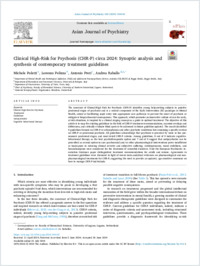Clinical high-risk for psychosis (CHR-P) circa 2024 : synoptic analysis and synthesis of contemporary treatment guidelines
- Poletti, Michele Department of Mental Health and Pathological Addiction, Child and Adolescent Neuropsychiatry Service, Azienda USL-IRCCS di Reggio Emilia, Italy
- Pelizza, Lorenzo Department of Biomedical and Neuromotor Sciences, Università di Bologna, Italy
- Preti, Antonio Department of Neuroscience, University of Turin, Italy
- Raballo, Andrea ORCID Chair of Psychiatry, Faculty of Biomedical Sciences, Università della Svizzera italiana, Switzerland - Cantonal Sociopsychiatric Organisation, Mendrisio, Switzerland
- 2024
Published in:
- Asian journal of psychiatry. - 2024, vol. 100, no. 104142
English
The construct of Clinical-High Risk for Psychosis (CHR-P) identifies young help-seeking subjects in putative prodromal stages of psychosis and is a central component of the Early Intervention (EI) paradigm in Mental Health, aimed at facilitating rapid entry into appropriate care pathways to prevent the onset of psychosis or mitigate is biopsychosocial consequences. This approach, which promotes an innovative culture of care for early, at risk situations, is inspired by a clinical staging concept as a guide to optimal treatment. The objective of this article is to map the existing guidelines in the field of CHR-P treatment recommendations, examine overlaps and differences, and critically evaluate blind spots to be addressed in future guideline updated. The search identified 9 guidelines focused on CHR-P or schizophrenia and other psychotic conditions but containing a specific section on CHR-P or prodromal psychosis. All guidelines acknowledge that psychosis is preceded by more or less pronounced prodromal stages, and most detail CHR-P criteria. Among guidelines, 8 out of 9 indicate cognitive-behavioural therapy as the best psychotherapeutic option and 7 out of 9 suggest that antipsychotics can be prescribed as second option in case psychosocial and/or other pharmacological interventions prove insufficient or inadequate in reducing clinical severity and subjective suffering. Antidepressants, mood stabilizers, and benzodiazepines were considered for the treatment of comorbid disorders. Only the European Psychiatric Association Guidance paper distinguished treatment recommendations for adults and minors. Agreements in treatment guidelines were discussed in light of recent meta-analytical evidences on pharmacological and non-pharmacological treatments for CHR-P, suggesting the need to provide an updated, age-sensitive consensus on how to manage CHR-P individuals.
- Collections
- Language
-
- English
- Classification
- Medicine
- License
- Open access status
- hybrid
- Identifiers
-
- DOI 10.1016/j.ajp.2024.104142
- ARK ark:/12658/srd1331206
- Persistent URL
- https://n2t.net/ark:/12658/srd1331206
Statistics
Document views: 82
File downloads:
- Raballo_2024_Elsevier_Asian journ psych_Clinical High-Risk for Psychosis: 75
